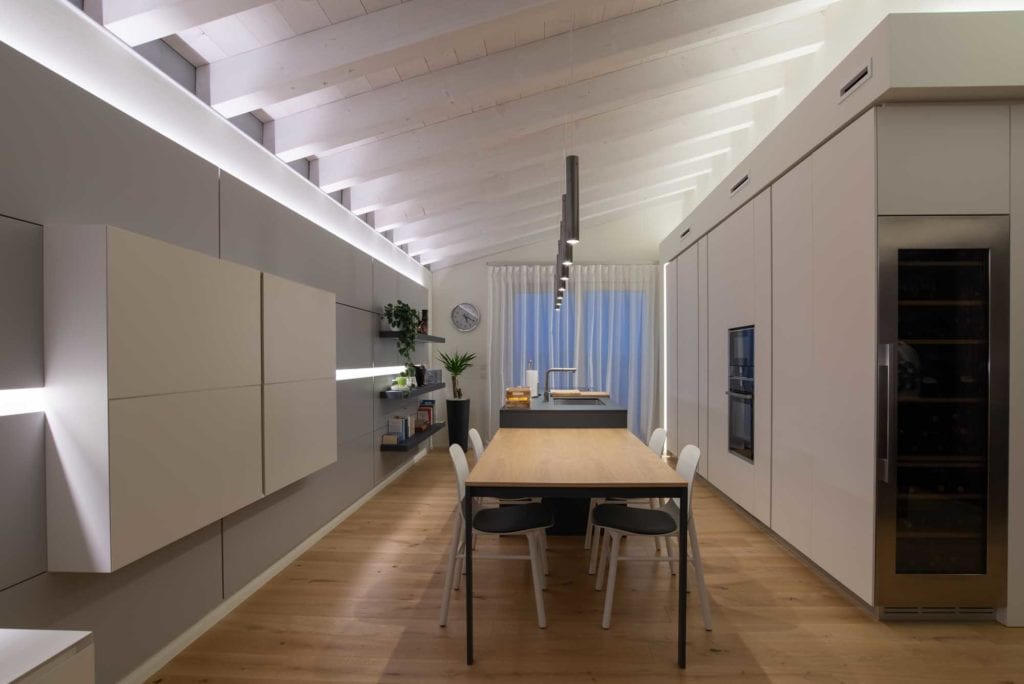Dr. Rita Berto and Dr. Giuseppe Barbiero, both engaged in the Biosphera project together with OLEV, explain how to plan a lighting scheme that enhances people’s well-being.
Us human beings are extremely sensitive to the characteristics of our physical surroundings and that is exactly how the ideas that shape our behaviour – in a more or less deliberate way – originate.
Light is a feature of the environment which can alter the colour perception of the elements that it contains, and colours may affect our behaviour.
Would you drink a glass of orange juice if it looked blue, or maybe some red milk? And how many times you looked pale just because you were under the wrong light?
Colour rendition is the ability of a light source to translate the colour of an object as faithfully as natural light would do. It is an essential quality, because recognizing these characteristics carries an adaptive value for us human beings, which has proved to be a useful mechanism of survival throughout the history of our evolution.
The impact of colour rendition on work efficiency and satisfaction is not clear yet.
In this particular case it is probable its effect may not be as direct as it is on the taste perception of food and drinks, but indirect, which means it operates on mood.
Light effects, particularly warm vs. cold light, act like mood inducers, so they stimulate a certain tone – just like it happens with the sun – and as a consequence they enhance work efficiency.

This is especially true for women, who are more sensitive than men to the environmental conditions that favour positive tones, like warm light hues.
Lighting design is surely a more complex subject than it may seem at first sight, because unlike other elements of an indoor environment, artificial lighting alternates and changes in relation to the natural light coming through the windows or to the materials inside the space.
Illuminating a room is not enough anymore. The lighting has to be studied not just according to its purpose, but also considering the regenerative requirements of an individual, and to this end it should recreate natural light as much as possible.
Our biological clock requires the right light pointers to operate properly, which means we need to receive the exact amount of light our body demands throughout the day. However, it is not just a question of quantity, but also of light intensity.
As well as not providing an optimal vision, over-illuminated spaces also have a stress-inducing effect on the organism.
A well illuminated environment is designed according to the characteristics of the visual system, of the light and of the materials or finishes inside the setting.
However, it shouldn’t overlook the importance of the peripheral vision and the functional role played by shadows.
Man has evolved in an environment which needed to be explored and searched all around. A lighting scheme focused directly on objects or surfaces only favours the foveal human vision and doesn’t reflect the original conditions in which our sight developed.
Most of all, it doesn’t benefit the “explorative” vision that guided our ancestors in the process of discovery of their natural surroundings.
It’s important to assist the peripheral vision indoors as well, and this can be achieved thanks to a lighting that changes its intensity in different locations of the environment.
- Zona cucina illuminata da OLEV
- Zona relax illuminata da OLEV
- Villa Privata illuminata da OLEV
Peripheral vision conveys depth to the spaces highlighting the proportions of the elements inside the environment, and draws the attention towards objects and materials creating contrasts with shadows or glare.
All these perception stimuli help us develop a sense of here-ness, which is a feeling of identity with the place where we are.

This has originated our need for a new kind of lighting which doesn’t just illuminate a space anymore, but also favours the Man-Nature biophilic bond and the personal regenerative requirements.
We may not be aware of it, but our preferential response to indoor environments is influenced precisely by the biophilic bond between man and nature and by our need for psycho-physical regeneration.
Biophilia is the innate attraction that us human beings have towards nature and all the things that remind us of it.
When we find ourselves in any environment, we unconsciously start looking for features of the natural environment originally inhabited by our species – the more elements we recognize, the more we like that setting.
Our preference for certain indoor spaces is influenced by our perception of regeneration. We choose according to the level of well-being which the environment offers, in terms of regeneration from mental fatigue and psycho-physical stress.
Psycho-physical well-being requires a light that changes throughout the day, just like the different tasks we have to complete.
Artificial light can’t replace natural light, but it can be a great ally in maintaining and stimulating the psycho-physical well-being, when it’s studied and designed following the principles of biophilia.
Light has to support our necessity to understand and explore our surroundings. Certain characteristics of the environment, such as its coherence, complexity, and mystery can help in these processes, especially if they are wisely exploited with the right lighting.
Visual comfort is the level of regeneration granted by artificial light and it’s often overlooked when architectural projects ignore the importance of the biophilic bond between man and nature for the interior design.
When we experience an environment, “the whole is something else than the sum of its parts”, since all the single elements interact with each other.
Lighting plays a key role in the environment, because unlike other features it acts directly on the affective-emotional aspect conditioning our preference for that same environment and our perception of immediate regeneration.
For this reason, it’s essential to study carefully the regenerative dimension of the light in the realization of different architectural projects and design a lighting scheme not according to its primary purpose, to the style of the decor or the furniture, but to the Man-Nature biophilic relation.
By doing this, lighting design become a matter of health, as it has direct influence on the human psycho-physical well-being.
Rita Berto e Giuseppe Barbiero sono autori del Biophilic Quality Index (BQI, Indicatore di Qualità Biofilica; Berto e Barbiero, 2017) strumento rivolto ad architetti e progettisti che consente di valutare quanto un progetto è biofilico/rigenerativo. Una sezione del loro strumento è dedicata alla luce.






